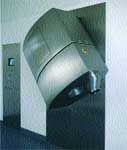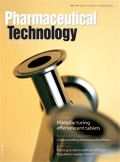Effervescent Dosage Manufacturing
Pharmaceutical Technology Europe
Oral dosage forms are the most popular way of taking medication, despite having some disadvantages compared with other methods. One such disadvantage is the risk of slow absorption of the active pharmaceutical ingredient (API), which can be overcome by administering the drug in liquid form and, therefore, possibly allowing the use of a lower dosage.
Oral dosage forms are the most popular way of taking medication, despite having some disadvantages compared with other methods. One such disadvantage is the risk of slow absorption of the active pharmaceutical ingredient (API), which can be overcome by administering the drug in liquid form and, therefore, possibly allowing the use of a lower dosage. However, because many APIs only show a limited level of stability in liquid form, effervescent tablets, which are dissolved in water before administration, have been formulated as an alternative dosage form.
Advantages of effervescent tablets compared with other oral dosage forms include:
- an opportunity for formulators to improve the taste;
- a more gentle action on a patient's stomach;
- marketing aspects (fizzy tablets may have more consumer appeal than traditional dosage forms).
The disadvantages of effervescent dosage forms are the need for larger tablets, a complex production process and, very often, the need for specialist packaging materials.

Citric acid and sodium bicarbonate
Fundamentals of effervescents
Effervescents consist of a soluble organic acid and an alkali metal carbonate salt, one of which is often the API. Carbon dioxide is formed if this mixture comes into contact with water. Typical examples of the acids and alkalis used include:
- citric acid
- tartaric acid
- malic acid
- fumaric acid
- adipic acid
- sodium bicarbonate
- sodium carbonate
- sodium sesquicarbonate
- potassium bicarbonate
- potassium carbonate
See sidebar "Citric acid and sodium bicarbonate" for an example.
Production
Producing effervescent tablets requires a conventional solid dosage form manufacturing process that has been adapted to include additional features because of the unique characteristics of the product.

Figure 1: Example of closed powder handling using IBCs, docking stations and split valve technology (courtesy of Gallay Systems Ltd, UK).
Material handling. The primary material used in the manufacture of effervescents is relatively hygroscopic, that is, it absorbs moisture from the air. However, this must be prevented because it will initiate the effervescent reaction. One of the principle strategies used to overcome this problem is a completely closed material handling system, which includes intermediate bulk containers (IBCs), docking stations and split valve technology (Figure 1). In addition, the ventilating air must contain a sufficiently low moisture content. This method is particularly useful if potent actives are handled that require a high level of operator protection. The alternative is the open handling of a product, which allows the use of standard equipment - although the ventilating air must still contain minimum moisture levels.
Granulation and drying
Because most tablets are compressed by high speed rotary tablet presses, the material fed into the presses has to have properties that prevent segregation and ensure homogeneous filling of the dies, to produce tablets of equal weight. The most common approach to achieving materials with these characteristics is to granulate the raw materials. Because wet granulation will initiate the effervescent reaction, several alternatives have been established.
Dry methods. Dry methods, such as slugging, direct compression and roller compaction are regularly used to produce solid dosage forms.2 These are the preferred methods of producing effervescents because no liquid is involved, which means that no additional drying step is required. Another advantage is the reduced need for equipment because of the limited number of unit operations required and, as a consequence, ventilation of the machinery and/or the facility can be simplified.
Indeed, the roller compaction method, if properly automated, can lead to very high throughput. However, the main argument against the use of dry methods is the need for expensive excipients.
Wet granulation. For the wet granulation process, two separate granulation steps are run (one each for the alkaline and the acid components) with a subsequent dry blending step. This can be done in a high shear granulator (with subsequent drying), a single pot or in a fluid bed spray granulator.2 The advantage of this method is that only conventional equipment is needed, which could also be used for granulating and drying other materials. The major disadvantages are the running time required and the cleaning, particularly if two parallel lines are not available for the two granulations. The blending process can be a critical step and may affect the homogeneity of the tablets because not all the materials are bonded into one granule as in a conventional wet granulation process.
Organic solvents. Because the effervescent reaction is only started if the materials come into contact with water - and not if they come into contact with organic solvents - one possibility is to use such solvents as a granulation fluid. This can be executed in a high shear granulator (with subsequent drying), a single pot or in a fluid bed spray granulator.
The method offers a number of advantages, which originate from the lower heat of evaporation when compared with water; high throughput; the possibility of drying at lower temperatures; and the freedom to use a number of different excipients to achieve the desired product characteristics.
The only disadvantage of this method is the need for more complex equipment to handle the fluids. If a fluid bed is used, then a complex system for exhaust gas treatment is required because the mixture of organic vapour and a large amount of non-condensable process gas has to be treated. This would not be the case in a tray dryer or a single pot as only the organic vapour has to be handled. Figure 2 shows an example of a single pot.

Figure 2: Single pot processor Ultima 75 (courtesy of Collette NV, Belgium).
Water. It is actually possible to use water as a granulation fluid. Only a very small amount of water is added, which initiates a pre-effervescent reaction; this results in some carbon dioxide being released but water is also produced, which consequently acts as the granulation fluid, producing more carbon dioxide and more water. The cycle must be stopped at a certain point by starting the drying process and removing the water. This can be done using a high shear granulator with subsequent drying by discharging the material into a pre-heated fluid bed dryer at the end of the granulation process. The most critical step is the discharge and transfer operation, hence this method works well for small and medium batch sizes; however, it may may lead to problems for larger batch sizes because of the long time needed for this operation.
A second variation is to use a single pot,3 in which the granulation process can be aborted by switching to the drying mode. Drying, in this situation, can be enhanced by using a double jacket and vacuum system or by using gas or microwave technology. Again, this would be acceptable for small or medium batches but, because of a poor surface:volume ratio, would be too slow for larger batches.
Fluid bed spray granulation. Fluid bed spray granulation is a unique process in which granulation and drying take place simultaneously. This ensures a constant low moisture level, limiting the pre-effervescent reaction to a minimum. In addition, when using a fluid bed for drying, it is easy to achieve a very low final moisture level for storage. The dis-advantage is that more granulation fluid is needed than in a high shear process.
Lubricants
It is common practice in tablet production to add a lubricant after granulation; the most commonly used substance is magnesium stearate. Its function is to improve the flow of the material, which is extremely important because the dies of a tablet press are filled by volume. A second function is to prevent the tablet sticking to the punch faces or to the walls of the dies.
During effervescent production, substances such as magnesium stearate should not be used because they are insoluble in water and, consequently, a film will form on top of the water after the tablet has dissolved. Strategies to overcome this problem are the use of other lubricants that are soluble in water; for example, a mixture of spray dried L-leucine and polyethylene glycol.4,5 Alternatively, not using any lubricant has the advantage of avoiding the blending step, but the disadvantage of special requirements for the tablet press.
Tablet compression
The compression of effervescent tablets is different from the compression of normal tablets. For long-term storage, a very low moisture content is required - typically less than 0.3% water compared with approximately 2% for traditional tablets. Additionally, effervescent tablets are usually quite large, which often leads to insufficient tablet hardness and consequently broken or damaged tablets. This, in turn, results in a poor yield and also a need to stop the press or packaging line. One way of overcoming this problem is to increase dwell time by modifying the precompression assembly of the tablet press.
If working without a lubricant, the poorer flow characteristics of the material can be addressed using a constant level powder feed system. This consists of a rotary valve guaranteeing constant powder pressure on the forced filling station which, in connection with two independently driven feed wheels, will ensure accurate filling of the dies. The second problem, when working without a lubricant, is that the tablets may stick to the die walls or on the punch faces. This issue can be overcome using a punch face and die wall lubrication system, which allows the addition of a very small amount of solid or liquid lubricant to the punch faces and the die walls just before they come in contact with the granules (Figure 3).

Figure 3: Punch face and die wall lubrication system (courtesy of Courtoy NV, Belgium).
It should be noted that because of their design, tablet presses easily accommodate the processing of effervescent materials and only release dry air into the compression zone, removing the need to vent the complete room.
Packaging
After the material has been pressed into tablets, the surface area of the material has been significantly reduced, which means that the rate at which moisture is absorbed from the air has also been reduced. Consequently, the dehumidification of the environmental air is now less critical.
Blisters and tube arrangements are used for packaging; for example, standard packaging materials are used in the packaging of food products or some nutraceuticals where shelf-life is not critical. This is not acceptable for pharmaceutical products. Aluminium, which has low water permeability, is used instead of standard polymer blister materials. If ten or more individual tablets are packed into one tube, very dry air can be added but as the patient opens the tube to take out the first tablet, ambient moist air will enter and destroy the remaining effervescent tablets. To overcome this, silica gel or other drying agents are incorporated into most tube lids.
Conclusion
Effervescents are an interesting pharmaceutical dosage form offering some unique advantages compared with traditional tablets. The manufacturing process involves some critical steps that need to be addressed carefully during formulation and factory design.

Pharmaceutical Tariffs Are Imminent: How Industry is Bracing for Impact
April 16th 2025On April 14, 2025, the Trump Administration launched a national security-driven investigation into pharmaceuticals, a move that will likely result in tariffs being placed on pharmaceutical drugs, ingredients, and other components that are imported from outside of the United States.
Drug Solutions Podcast: A Closer Look at mRNA in Oncology and Vaccines
April 30th 2024In this episode fo the Drug Solutions Podcast, etherna’s vice-president of Technology and Innovation, Stefaan De Koker, discusses the merits and challenges of using mRNA as the foundation for therapeutics in oncology as well as for vaccines.